| PREP TIME | REST TIME | COOK TIME |
| 20 mins | 1 to 6 h | 10 to 15 mins |
Steak with chimichurri sauce is one of those combos that just never misses. The bright, herby flavor of chimichurri pairs perfectly with the richness of the steak, and it’s honestly one of my favorite sauces for beef. In this recipe, I’ll show you how to make the chimichurri sauce and how to pan-sear an outside skirt steak that is about 0.5 inch (1.3 cm) thick.
Skirt steak is the classic cut to serve with chimichurri because it’s full of flavor, tender, and cooks fast. However, you can also use other cuts, such as hanger, flank, or even ribeye. Just remember to adjust the cooking method for the thickness and type of steak you’re using.
Important
If you prefer a different cooking method than pan-searing, feel free to use it. You can still use this recipe just for the chimichurri sauce and cook the steak however you like. And if you’re looking for ideas, check out some of my other steak cooking guides, or take a look at my ultimate guide to cooking any type of steak.
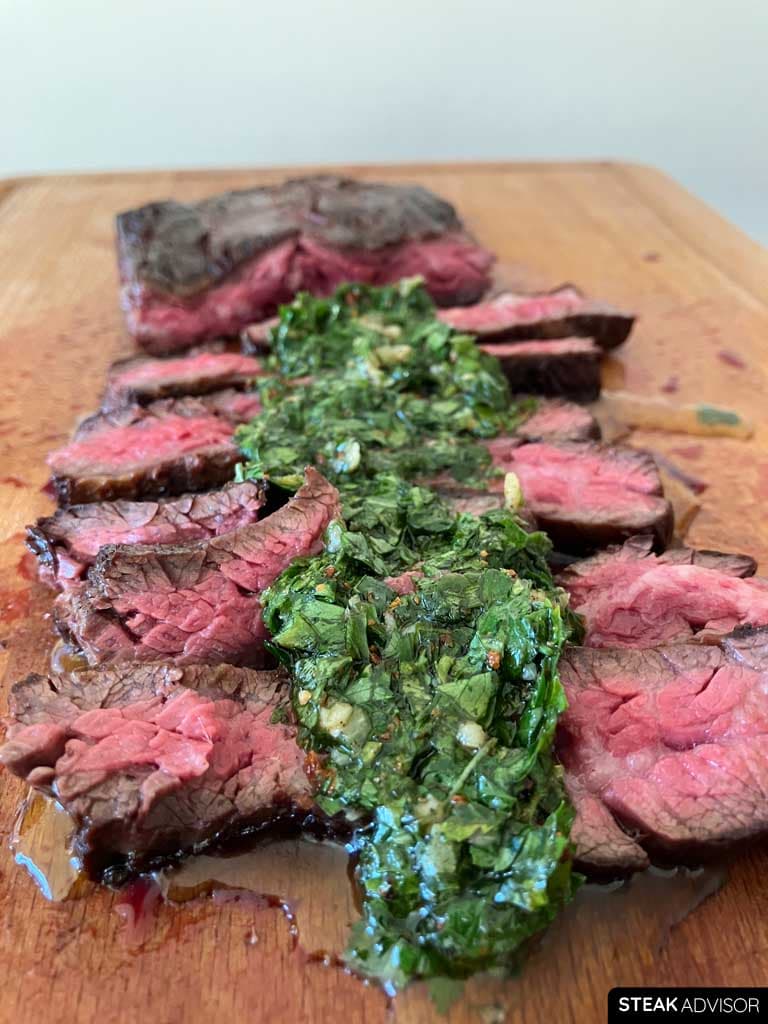
This recipe is for a naturally tender steak, so no marinade is needed. When it comes to skirt steak, a lot of people blame the cut for being tough, but most of the time, they don’t know there are actually two types of skirt steak: inside skirt steak and outside skirt steak. You want the outside skirt steak for this recipe. It’s flavorful, well-marbled, and naturally tender. All it really needs is salt and pepper. The inside skirt, on the other hand, is a different story. It’s naturally tougher and chewier, so the only way to make it enjoyable is to marinate it first. But like I mentioned earlier, you can also use other tender cuts with chimichurri sauce. It doesn’t have to be skirt or flank steak every time.
As for the chimichurri sauce, I recommend making a bigger batch. The amount in this recipe is perfect for a few steaks, but since it takes a bit of time to prepare, it just makes sense to make extra. You can store it in the refrigerator for up to a week and use it on a variety of dishes. And if you end up with leftover steak, do yourself a favor and try a chmichuri steak sandwich. It’s simple, quick, and you can have it ready in about 10 minutes with leftover steak and sauce.

What Is Chimichurri?
Chimichurri is a traditional South American sauce that’s served fresh (uncooked). It’s made with finely chopped flat-leaf parsley or cilantro (or both), a bit of chopped oregano leaves, minced garlic, olive oil, red wine vinegar, roasted red pepper or red pepper flakes, sometimes shallot, and of course, some salt and pepper to taste. The exact ingredients depend on the version you’re making (green chimichurri or red chimichurri), but the green one is by far the most popular. That’s the one I’ll show you how to make in this recipe.
Chimichurri is best known as the go-to sauce for grilled meats, especially steak, but it’s great on just about anything: fish, roasted vegetables, and even sandwiches. It adds a bright, herby kick to just about anything.

The Ingredients You’ll Need
For Steak:
- Steak: Choose a tender cut between 0.5 and 2 inches (1.3–5 cm) thick. The most common cuts to serve with chimichurri are outside skirt steak and flank steak, but you can use any tender cut you prefer, such as flat iron, strip steak, ribeye, hanger, bavette (also known as flap), or even picanha. The key is choosing something naturally tender that doesn’t need a marinade.
- High-smoke-point oil: 1-2 tablespoons (15-30 ml). Since we’re pan-searing the steak, it’s important to use an oil that can handle high heat without burning. Refined avocado oil is my favorite; it has a neutral flavor and a high smoke point of about 500°F (260°C).
- Kosher salt: Use 1–2 teaspoons (5–10 g), depending on the size of your steak. As a general rule, go with about 1% of the steak’s weight in salt, or up to 1.5% if you like a stronger, more seasoned flavor. Always use kosher salt; it spreads evenly and gives you much better control than table salt.
- Black pepper: Around ½ teaspoon per 1 pound (453 g) of steak. Use finely ground black pepper.
For chimichurri sauce:
- Olive oil: 1/2 cup (120 ml)
- Red wine vinegar: 2 tablespoons (30 ml).
- Parsley: 1 cup tightly packed fresh parsley leaves (stems removed).
- Garlic: 3-4 cloves, peeled.
- Red pepper flakes: 1 teaspoon.
- Oregano: 1/4 cup tightly packed fresh oregano leaves (stems removed).
- Salt: 1/2 teaspoon table or 1 teaspoon kosher salt.
- Black pepper: 1/2 teaspoon.
How to Make Chimichurri Steak – Step by Step Photos
First, gather all your ingredients. Then follow the steps below, one by one. The photos will walk you through the whole process. Start by dry-brining the steak, then make the chimichurri, and finally cook the steak.
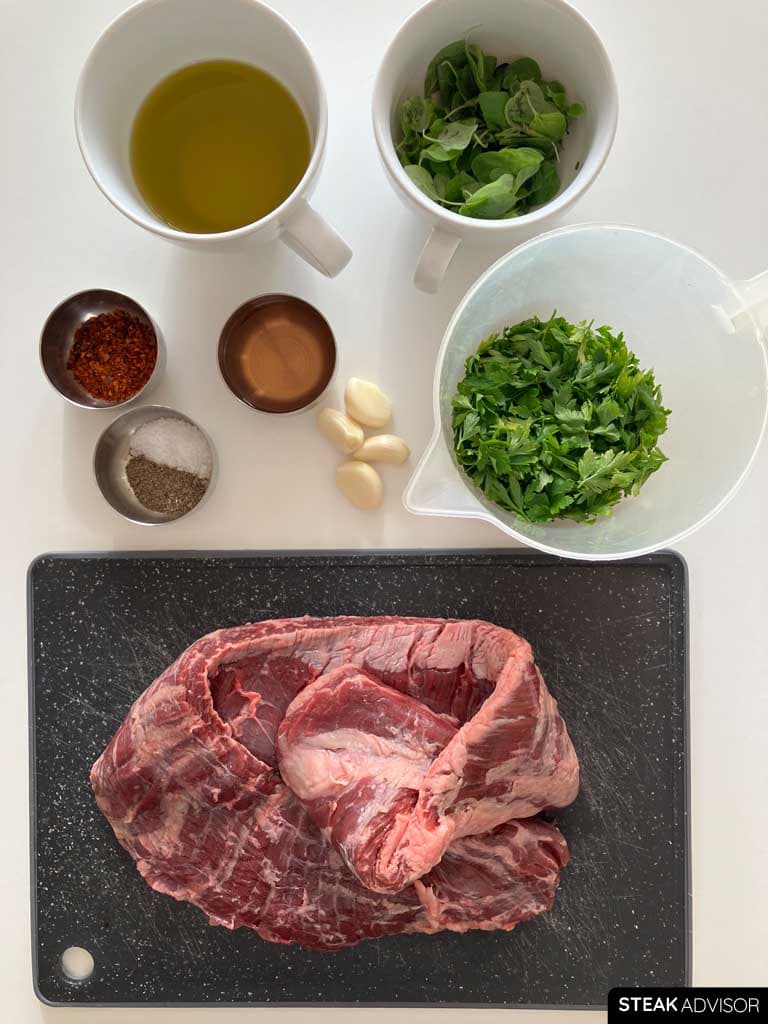
Step 1: Prepare the Steak
For this recipe, I’m using a skirt steak that I will pan-sear, but most of these steps apply to almost any other cut of steak. If you need help with a specific one, check out my pan-seared steak recipes – there you’ll find guides for flank, hanger, picanha, and more.
Start by patting the skirt steak dry with paper towels, then trim off any excess fat if needed. If you’re working with a whole skirt steak muscle, cut it into smaller pieces, about 4–8 inches (10–20 cm) long, with even thickness (see note). Next, season both sides of the steak generously with kosher salt. Place it on a wire rack set over a baking sheet and refrigerate it uncovered for at least 1 hour, ideally 4–6 hours.
Before cooking, remove the steak from the refrigerator and let it rest at room temperature for 20–30 minutes. While the steak rests after being seasoned with salt, prepare the chimichurri sauce.
Note
The whole outside skirt steak muscle is pretty long and won’t fit in the pan, so it’s best to cut it into smaller pieces. When cutting, try to keep a consistent thickness, as the whole muscle can vary in thickness from approximately ¼ inch to an inch (0.6 to 2.5 cm) in different spots. Keeping each piece even helps it cook at the same rate. That way, it cooks more evenly.
What’s the Purpose of Dry Brining? In short, dry brining helps your steak taste better, makes it slightly more tender, and dries out the surface, resulting in a much better sear later. With a thin cut like skirt steak, around ½ inch (1.3 cm) thick, the biggest challenge is getting a nice crust while keeping the inside at medium-rare or medium doneness. That’s where dry brining and patting the steak really dry before searing makes all the difference.
So, why do I suggest 1 to 6 hours of dry brining instead of overnight? It’s simple:
- 1 hour is just the bare minimum to notice any effect.
- With 4–6 hours, you get all the flavor and texture benefits without forming a thick, gray band inside the steak.
- Overnight dry-brining: It makes the meat taste incredible, but it also leaves a noticeable gray band just under the crust, no matter how you cook it.
Still, if you don’t mind the gray band inside, leave the salted steak in the fridge overnight for even better flavor. It’s totally up to you and the results you want with your steak. I’m just showing the options.
Very important: Don’t sear the steak between 2 minutes and 45 minutes after salting. That’s the worst time. The surface will still be wet, and you won’t get any browning. If you want to learn more about how salt and dry brining work, check out my other guides:

Step 2: Make the Chimichurri Sauce
By hand: Remove the stems from the parsley and oregano, then finely chop the leaves. Add them to a small bowl. Peel the garlic and chop, grate, or press it (whatever’s easiest) and add it in. Add the olive oil, red wine vinegar, red pepper flakes, salt, and black pepper. Mix everything well, then give it a quick taste and adjust the seasoning if needed. Set the chimichurri sauce aside until you’re ready to use it.
In a food processor: Add the peeled garlic and pulse until minced. Toss in the parsley, oregano, red pepper flakes, salt, and black pepper, then pulse until finely chopped. Add the olive oil and red wine vinegar, then pulse a few more times to combine the ingredients. Please don’t overdo it; you want a little texture, not a smooth paste.
Note
I didn’t use cilantro in this recipe – just parsley. However, if you want both herbs, feel free to swap out half the parsley with cilantro. Or use only cilantro if that’s what you prefer. It’s totally up to you and the version of chimichurri you like. You can tweak the ingredients slightly, but try to keep the overall amount about the same so the sauce will still come out balanced.

Step 3: Preheat the Pan
Place a pan (preferably a cast-iron skillet) over medium-high heat and let it heat up for about 3 minutes. Add the high-smoke-point oil (about 1 tablespoon for well-marbled cuts, or 2 for leaner ones) and let it heat for an additional minute. While the pan is heating, pat the steak dry again with paper towels to remove any moisture on the surface, then season both sides with finely ground black pepper. After about 4 minutes in total, the pan should be hot enough, at about 450°F (232°C), perfect for a hard sear. Once you hit that range, you’re ready to cook the steak.
Note
Searing is a cooking technique that uses high heat to quickly brown the surface of the food (in this case, the steak). That’s what builds that deep, rich flavor and crust. To do it right, your pan needs to reach at least 400°F (204°C), and ideally around 450–500°F (232–260°C). You’ll need a pan that can handle that kind of heat. Don’t use non-stick pans, as they’re not designed for high temperatures. Cast iron, carbon steel, or a heavy-bottomed stainless steel skillet are your best options. They hold heat well.
In my experience, using a cast-iron skillet on a gas stove, it typically takes 3–4 minutes of preheating to reach a temperature of around 450–500°F (232–260°C). You can check it with an infrared thermometer if you have one (it’s not an expensive gadget). When it comes to oil, pick something with a high smoke point, ideally around 500°F (260°C). My go-to is refined avocado oil because it has both a high smoke point and a neutral flavor. Of course, you can use another oil if you prefer, but ensure it can handle high heat. Here are a few good options:
| Type of Fat | Smoke Point ºF | Smoke Point ºC |
|---|---|---|
| Refined Avocado Oil | 520ºF | 270ºC |
| Refined Safflower Oil | 510ºF | 266ºC |
| Beef Tallow | 480ºF | 250ºC |
| Pecan Oil | 470ºF | 243ºC |
| Refined Peanut Oil | 450ºF | 232°C |

Step 4: Pan-Sear the Steak
Carefully place the steak in the pan so the oil doesn’t splash, then sear it based on the thickness of your skirt steak:
For steaks about ½–1 inch (1.3–2.5 cm) thick: Flip the steak every 30 seconds. Use a meat thermometer to monitor the internal temperature and remove the steak when it’s about 10–15°F (5–8°C) below your target doneness (see the temperature chart below). Then let it rest for about 5 minutes before slicing. Skirt steaks in this range typically take 3–6 minutes to reach medium-rare to medium, depending on their thickness.
For thinner cuts (½ inch / 1.3 cm or less): Flip the steak every 30 seconds and slide it around the pan every 15 seconds to move it over the hotter spots (this trick helps build a better crust). Since it’s hard to use a thermometer with thinner cuts, rely on timing instead. For medium-rare to medium doneness, expect about 60–90 seconds total for a ¼-inch (0.6 cm) steak, or 2–3 minutes total for a ½-inch (1.3 cm) steak. After cooking, let the steak rest for 5 minutes before slicing.
| Doneness | Remove at temp: | Final temp: |
| Rare | 105–115°F (40–46°C) | 120–130°F (49–54°C) |
| Medium Rare | 115–125°F (46–52°C) | 130–140°F (54–60°C) |
| Medium | 125–135°F (52–57°C) | 140-150˚F (60–66°C) |
| Medium-Well | 135–145°F (57–63°C) | 150-160˚F (66–71°C) |
| Well Done | 145–155°F (63–68°C) | 160°F+ (71°C+) |
For thicker cuts, about 1.5 to 2 inches (3.8–5 cm), flip every 30 seconds. Remove the steak from the pan when it’s about 15–20°F (8–11°C) below your target temperature, then let it rest for 6–7 minutes before slicing.
Note
Remember to pat the steak dry with paper towels right before placing it in the pan. That’s the key to getting a very good crust.
Flipping often helps the steak cook more evenly on both sides, minimizes the gray band under the crust, and actually helps it cook a little faster.
As for removing the steak early, that’s because when you’re cooking over high heat, you need to keep carryover cooking in mind. Removing the steak from the pan doesn’t stop the cooking process; the heat inside the meat keeps going. As it rests, for about 5–10 minutes, the internal temperature climbs another 10 to even over 20°F (5–11°C), depending on the steak’s thickness, cooking temperature, and total cooking time. That’s why removing it from the heat a little early gives you the perfect doneness once it’s rested.
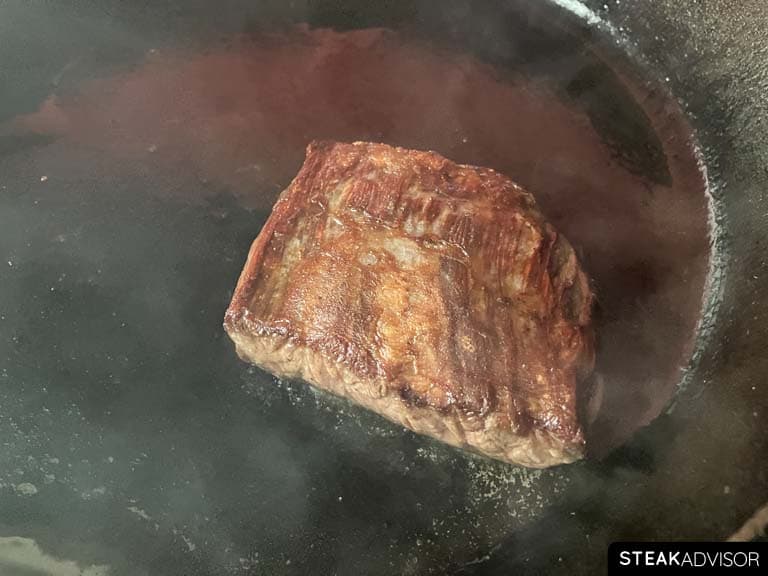
Step 5: Serve the Steak with Chimichuri Sauce
Once the steak has rested, slice it thin. For cuts like skirt, hanger, flank, or flap (bavette), always slice against the grain. It makes a big difference in tenderness (see the note below). Serve the steak with chimichurri sauce spooned on top and add your favorite sides. I usually go with baked potatoes and zucchini, but it’s also great in a simpler version with rice or mashed potatoes.
Note
If you removed the steak 10–20°F (5–11°C) below your target doneness, ensure that it rests for at least 5 minutes for thinner cuts or 6–7 minutes for steaks about 1.5 inches (3.8 cm) thick. Don’t skip this step, or the inside will end up undercooked. The only time it makes sense to slice right after removing the steak from the pan is when your thermometer shows that it has already reached your target temperature.
And don’t forget: for cuts with long, visible muscle fibers, such as skirt steak, flank steak, or flap (bavette), always slice them against the grain. Slicing against the grain shortens those muscle fibers, making every bite a lot easier to chew. If you slice with the grain, the meat turns out chewy and tough instead. See the photo below for an example of how to slice skirt steak properly against the grain.

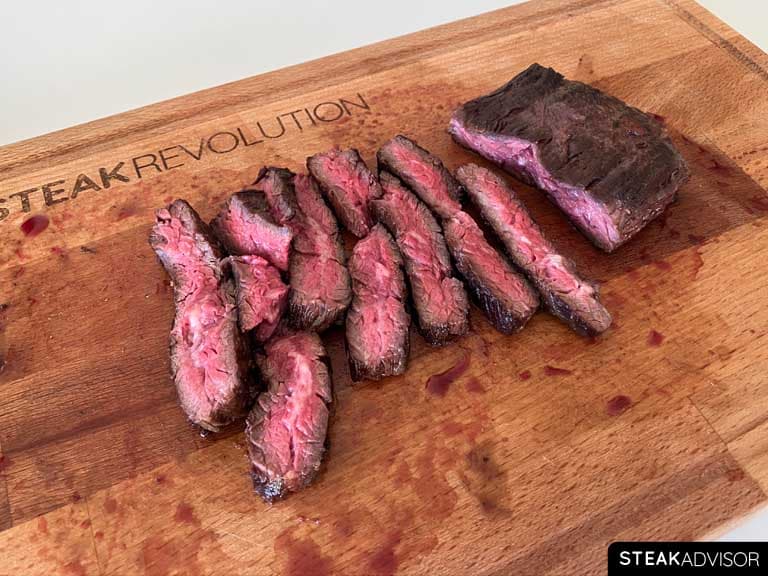

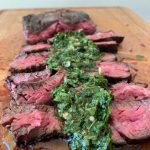
Chimichurri Steak Recipe (Any Cut: Flank, Skirt, Hanger)
- Prep Time: 20 minutes
- Rest Time: 1 to 6 hours
- Cook Time: 10 mins
- Total Time: 30 minutes
- Yield: 1 steak
Description
Tender, juicy pan-seared skirt steak served with fresh, garlicky chimichurri sauce is a classic combo that never misses. This recipe demonstrates how to make the sauce from scratch and cook an outside skirt steak (or any cut of your choice) to perfection.
Ingredients
For the Steak:
- between 0.5 and 2 inches (1.3–5 cm) thick steak (choose a naturally tender cut).
- 1–2 tablespoons (15–30 ml) High-Smoke-Point Oil (I recommend refined avocado oil).
- 5–10g kosher salt, depending on the size of your steak (go with about 1% of the steak’s weight in salt, or up to 1.5% if you like a stronger, more seasoned flavor).
- ½ teaspoon black pepper per 1 pound (453 g) of steak (use finely ground black pepper).
For Chimichuri Sauce:
- 1/2 cup (120 ml) olive oil.
- 2 tablespoons (30 ml) red wine vinegar.
- 1 cup tightly packed fresh parsley leaves (stems removed).
- 3–4 garlic cloves, peeled.
- 1 teaspoon red pepper flakes.
- 1/4 cup tightly packed fresh oregano leaves (stems removed).
- 1/2 teaspoon table or 1 teaspoon kosher salt.
- 1/2 teaspoon black pepper.
Instructions
For this recipe, I’m using a skirt steak that I will pan-sear, but most of these steps apply to almost any other cut of steak. If you need help with a specific one, check out my pan-seared steak recipes – there you’ll find guides for flank, hanger, picanha, and more.
- Prepare the Steak: Start by patting the skirt steak dry with paper towels, then trim off any excess fat if needed. If you’re working with a whole skirt steak muscle, cut it into smaller pieces, about 4–8 inches (10–20 cm) long, with even thickness (see notes). Next, season both sides of the steak generously with kosher salt. Place it on a wire rack set over a baking sheet and refrigerate it uncovered for at least 1 hour, ideally 4–6 hours.
- Before cooking, remove the steak from the refrigerator and let it rest at room temperature for 20–30 minutes. While the steak rests after being seasoned with salt, prepare the chimichurri sauce.
- Make the Chimichurri By hand: Remove the stems from the parsley and oregano, then finely chop the leaves. Add them to a small bowl. Peel the garlic and chop, grate, or press it (whatever’s easiest) and add it in. Add the olive oil, red wine vinegar, red pepper flakes, salt, and black pepper. Mix everything well, then give it a quick taste and adjust the seasoning if needed. Set the chimichurri sauce aside until you’re ready to use it.
- In a food processor: Add the peeled garlic and pulse until minced. Toss in the parsley, oregano, red pepper flakes, salt, and black pepper, then pulse until finely chopped. Add the olive oil and red wine vinegar, then pulse a few more times to combine the ingredients. Please don’t overdo it; you want a little texture, not a smooth paste.
- Preheat the Pan: Place a pan (preferably a cast-iron skillet) over medium-high heat and let it heat up for about 3 minutes. Add the high-smoke-point oil (about 1 tablespoon for well-marbled cuts, or 2 for leaner ones) and let it heat for an additional minute. While the pan is heating, pat the steak dry again with paper towels, then season both sides with finely ground black pepper. After about 4 minutes in total, the pan should be hot enough, at about 450°F (232°C), perfect for a hard sear. Once you hit that range, you’re ready to cook the steak.
- Pan-Sear the Steak: Carefully place the steak in the pan so the oil doesn’t splash, then sear it based on the thickness of your skirt steak:
- For steaks about ½–1 inch (1.3–2.5 cm) thick: Flip the steak every 30 seconds. Use a meat thermometer to monitor the internal temperature and remove the steak when it’s about 10–15°F (5–8°C) below your target doneness (see notes for the temperature chart). Then let it rest for about 5 minutes before slicing. Skirt steaks in this range typically take 3–6 minutes to reach medium-rare to medium, depending on their thickness.
- For thinner cuts (½ inch / 1.3 cm or less): Flip the steak every 30 seconds and slide it around the pan every 15 seconds to move it over the hotter spots (this trick helps build a better crust). Since it’s hard to use a thermometer with thinner cuts, rely on timing instead. For medium-rare to medium doneness, expect about 60–90 seconds total for a ¼-inch (0.6 cm) steak, or 2–3 minutes total for a ½-inch (1.3 cm) steak. After cooking, let the steak rest for 5 minutes before slicing.
- For thicker cuts, about 1.5 to 2 inches (3.8–5 cm), flip every 30 seconds. Remove the steak from the pan when it’s about 15–20°F (8–11°C) below your target temperature, then let it rest for 6–7 minutes before slicing.
- Serve the Steak with Chimichuri Sauce: Once the steak has rested, slice it thin. For cuts like skirt, hanger, flank, or flap (bavette), always slice against the grain. It makes a big difference in tenderness (see the notes). Serve the steak with chimichurri sauce spooned on top and add your favorite sides. I usually go with baked potatoes and zucchini, but it’s also great in a simpler version with rice or mashed potatoes.
Notes

- For cuts with long, visible muscle fibers, such as skirt steak, flank steak, or flap (bavette), always slice them against the grain. Slicing against the grain shortens those muscle fibers, making every bite a lot easier to chew. If you slice with the grain, the meat turns out chewy and tough instead. See the photo below for an example of how to slice skirt steak properly against the grain.

Cut skirt steak against the grain: The yellow line indicates the grain direction, while the red line shows the cutting direction with the knife

